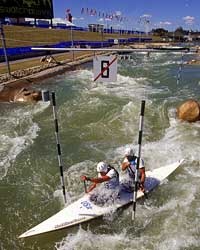 Clive Brunskill /Allsport/ Penrith Whitewater Stadium - Sydney Australia
Play in the same places where Olympic athletes made history.
Clive Brunskill /Allsport/ Penrith Whitewater Stadium - Sydney Australia
Play in the same places where Olympic athletes made history.
See our slideshow of Olympic Venues Open to the Public.
Mark Hobson, a 61-year-old creative director and wilderness guide, pushes his sled into the luge track in Lake Placid, New York, leans back, and rockets down the same ice chute used by the world’s best lugers in the 1980 Olympic Games. The clatter is deafening as he picks up speed, cranks into the turns, and drops 20 stories at a thrilling 65 mph.
“You're on your back a couple inches off the ice. It’s a real rush,” Hobson says of the experience. “We've had two Olympics here. It’s great to be part of that tradition.”
Like Lake Placid’s sports center, many Olympic venues stay open to the public after the flame has been extinguished. For host cities, the sites are a lasting physical legacy of the Games' grandeur, not to mention a good tourism draw. And for travelers, they're a great way to experience Olympic glory—if only for a moment.
Whether your passion is for summer or winter sports, you have plenty of options. The aquatically inclined can do laps at Georgia Tech’s $21 million Aquatic Center, constructed for the 1996 Games in Atlanta, and outfitted with an Olympic pool, diving well, and 184-foot waterslide. And at Utah’s Deer Valley resort, advanced skiers can schuss down Know You Don’t, the same alpine slalom run where Bode Miller took a silver during the 2002 Winter Games.
Into more extreme stuff?The same park boasts four massive ski jumps, the largest of which launches freestylers some 70 feet into the air and into a 750,000-gallon pool that’s “bubbled” to soften the impact.
“You can’t help but get pumped up when you're about to take your first run down the track or about to execute your first water ramp jump,” says Jon Green, the program manager for Utah’s park. “You think about all the athletes from around the world who have competed on the same ice or jumped into the same pool."
Like Utah’s park, which offers multiday freestyle camps, many Olympic venues provide formal instruction—sometimes from former Olympic athletes. Montreal’s Rowing Club offers private beginner classes at the city’s Olympic Basin, a 1.3-mile mirror-flat waterway built just for rowing during the 1976 Summer Games. This February, Lake Placid’s Olympic Center kicks it up a notch and hosts a weeklong fantasy camp where would-be Gretzkies can skate with members of the 1980 Games' USSR-beating “Miracle on Ice” U.S. hockey team.
And, unbeknownst to many, the International Olympic Committee operates a massive, 210-acre complex in Munich, Germany—site of the 1972 Games—that, like some Disney World of athletics, has facilities for almost every sport under the five rings' mantle, plus unorthodox fare like rappelling and roof climbing. There’s even a motion-simulation theater that provides a virtual experience of Olympic boxing, mountain biking, and kayaking.
Of course, if all of that sounds too much like a spectacle-laden theme park, it’s always easy to return to a simpler time in the Games' history: pack your trunks, grab a flight to Athens, and head for the cobalt-blue Aegean Sea. It was there that swimmers battled 12-foot waves and frigid temperatures to compete in the first modern Olympics back in 1896. In the water, close your eyes and imagine the roaring crowd and the rush of adrenaline as you knife through the waves and push toward the finish line. Concentrate, and it will feel just like the real Olympics—only with a lot less pressure.